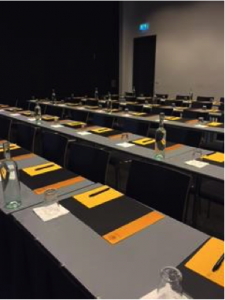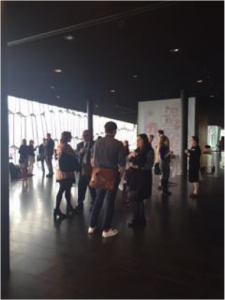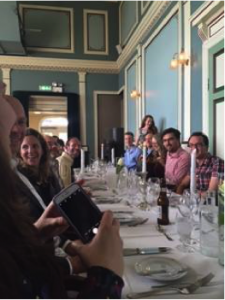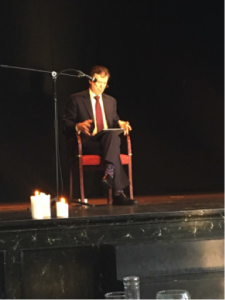Adapting Dickens, 11-13 July 2016
The following post provides a summary of the 2016 Dickens Society symposium, Adapting Dickens. Submit your abstract for our 2017 symposium, ‘Interdisciplinary Dickens’, taking place July 14-16 2017 at the College of General Studies, Boston University, here.

Contributors: Catherine Quirk, Lydia Craig, Laurie Strickland, Maureen England, and Andrea Schmidt
The 2016 Dickens Society Symposium, “Adapting Dickens,” welcomed consideration of every medium in which the literary work and life of Charles Dickens could be adapted. Apparent in the variety of papers presented at this conference, Dickens adaptations have existed since the author began publishing in the 1840s, whether put on for the stage, filmed as Hollywood blockbusters, or diegetically transposed or thematically updated across various languages and literatures. Over the course of the three-day symposium, presenters examined topics such as how Dickens incorporated, or “adapted” events from his own life into his fiction, discussed the many theatrical adaptations of Dickens novels that have been staged over the past three centuries, introduced international adaptions, reworkings, and updates of Dickens’s plots into other languages and cultures, and contrasted filmic adaptations of Dickens’s novels since 1900.
The Dickensian spirit was alive and well as we gathered from every corner of the globe to share our work on “Adapting Dickens.” Inspiring to see scholars and artists exploring, through the lens of Charles Dickens, the threads that connect us, and speaking to how we bring his work forward for the times we live in, the layers of meaning around that discussion. The following report, composed by graduate student attendees, gives a glimpse into some of the presentations featured at this year’s conference. Enjoy!
Day One, Morning Sessions

© Laurie Strickland
Panel 1, “Stage Adaptations,” chaired by Nancy Metz, featured several contemporary attempts to adapt Dickens for staged readings and local theatre. Joel J. Brattin started off with a “Adapting Dickens’s Works for Staged Readings: Challenges and Opportunities.” Demonstrating how Dickens’s prose and descriptions change in spoken performance, Brattin, Metz, and several other conference participants enacted a scene from Great Expectations (1861) in which Pip confesses to Joe that he lied about what he did at Miss Havisham’s house. During this reenactment, Metz repeatedly struck Brattin about the head and shoulders with her script, clearly having more fun than the average panel chair. =
Following Brattin, Elizabeth Bridgham discussed the Trinity Repertory Company Theatre’s production of A Christmas Carol (1843), drawing special attention to how its yearly Rhode Island audience has come to expect the play to be staged a certain way.
Laurie Strickland and Jamie Bullins jointly revealed the soul-searching that went into their own theatrical adaptation of A Christmas Carol. Though the production boasted elaborate pyrotechnics and stage design, Strickland felt that it required more of Dickens’s actual text to truly live up to the novel. She concluded that Dickens’s own longing for his past self as a child lies at the heart of Scrooge’s tale and appeals to all of its readers who experience the same nostalgia. Bullins spoke to the deep personal connection readers and viewers feel with Dickens, born out of the shared human experiences he so feelingly describes in his novels.
Daniel Siegel began Panel 2, ‘Sound and Silence in Dickens Adaptations,’ by looking at D. W. Griffith’s only Dickens adaptation, The Cricket on the Hearth. Siegel connected the two artists through this silent film, looking at the ways in which Griffith displayed Dickens’s characters’ metal and emotional struggles. Siegel claimed, ‘Both are working on ways in which to externalize the workings of the mind’ and that ‘Dickens made Griffith think about what thinking looked like.’ Andrea Schmidt continued the panel with a look at the 1930s German film Klein Dorrit. Schmidt balanced her analysis of the film between the adaptation itself and the historical and cultural time period. Sharon Aronofsky Weltman lightened things up a bit with her look at the ‘Opium Dream Ballet’ and the Mystery of Edwin Drood musical. A seemingly incongruous choice, the choice to make a musical out of Dickens’s unfinished novel always perplexed me. However Aronofsky Weltman cleared this question right up at the start, explaining ‘when emotion becomes too strong for speech- you sing. When emotion becomes too strong for song- you dance’. Matthew Ingleby concluded the panel with a look at the poem ‘Peter Grimes’ by George Crabbe and the subsequent opera by Benjamin Britten. I certain phrases and imagery, ‘oakum, tar, pitch, and fish’ are all present in both pieces. What we were left with in all three pieces was a look at Dickens and realism through diverse adaptations. All adaptors seem taken with Dickens’s representation of the poor and each subsequent interpretation is mediated through the social/political atmosphere surrounding and sometimes encroaching on the adaptation.
Dickens and the Code Breakers: The Annotated Set of All The Year Round

© Laurie Strickland
After lunch, Leon Litvack treated us to a special presentation on cracking the code of the recently discovered annotated set of All the Year Round. Litvack led us through his current project of literary investigation as he works to discover who really wrote the marginalia in the volumes. He has been using handwriting analysis and a bit of Dickensian imagination to rule out some of the early possibilities – W. H. Wills and Charley Dickens among them. Litvack ended his exciting presentation by outlining the painstaking work still to come and emphasising his goal to ‘get all the details right, and not to hurtle recklessly towards publication’.
Day One: Afternoon Sessions
Panel 10, “Dickens and Popular Culture,” looked at the ‘Dickens brand’ in the twentieth and twenty-first centuries. Juliet John discussed her recent work on Crowdsourced Dickens, which has illuminated the separation between academic and non-academic interactions with the author. John was followed by Laurena Tsudama on Joshua Cohen’s 2015 interactive online novel, PCKWCK, and how adaptation reveals the place of the author in both nineteenth-century and modern culture. Maureen England spoke about fanfiction and the growing prevalence – and acceptability – of academic fandom. Emily Bell closed the panel with a discussion of the BBC’s 2016 miniseries, Dickensian, and the changing definition of the term ‘Dickensian’. All four speakers touched on the progressive institutionalisation of Dickens, from the development of the ‘Dickens Brand’ in the nineteenth century to the many ways his novels have been revisited to express or address modern issues.
Commencing directly after Litvack’s presentation, Panel 3, “Dickens and Family,” chaired by Goldie Morgentaler, surveyed how Dickens and his family responded to their own relationships, literary gifts, and notoriety. In her paper on the Dickens brothers Lillian Nayder explored how Charles Dickens himself adapted elements of his own life into fiction, inserting references to his fraught relationship with his brother, the financially needy and morally reprehensible Frederick Dickens into A Tale of Two Cities.
Next, Matt Kerr theorized that Game of Thrones actor Harry Lloyd had dealt with his theatrical inheritance and “overbearing” literary heritage by embracing film as his own artistic medium. Unfortunately, as Kerr explained, for Dickens’s children “their father’s name was their best possession,” and none equaled his iconic literary and cultural stature.
Meoghan Cronin stated that in Dickens’s fiction, bedtime stories not only function as part of the narrative, but also work to reveal fantasy, thoughts, feelings, and destabilize or shift the walls of narrative, consciousness, and the childhood self.
Jennifer Miller rounded out the panel with a look at Nicholas Nickleby (1838) and The Old Curiosity Shop’s (1841) Victorian theatrical adaptations, focusing in particular on the dramatic portrayals of domesticity in these novels.
Panel 5, chaired by Andrew Maunder, focused on adaptations of Great Expectations in 20th century Anglo-American cinema. Christian Dickinson’s presentation focused on seventy years of screen adaptations of Great Expectations with an eye to the intersection of text, image, and sex appeal in each. Questioning whether fidelity should be the standard by which Dickens adaptations are judged, Dickinson pointed out that each film adaptation of Great Expectations illuminates a new, important side of the novel.
Picking up where Dickinson left off, Tien-Ai Chin considered how David Lean’s 1946 film adaptation depicts paper in both film and literal language in Great Expectations. Chin explained that Victorians in Dickens’s world often considered paper, as paper currency, to be useless, unreliable, and waste when compared to something more stable, such as solid gold coin. Thus, in Dickens’s novel, paper literally and figuratively embodies “great expectations.”
Julie M. Barst investigated Australia’s meaning in Great Expectations as an adopted home for Magwitch and an “adapted nation” for its originally English convict inhabitants. She stated that in Dickens’s novels, Australia “was seen as a transient space.” Tim Burstall’s 1987 film Great Expectations: The Untold Story depicts the novel’s events from an Australian perspective, filling in the gaps of Magwitch’s long exile and eventual financial success as a sheep farmer in England’s penal colony.
The final panel of the day, Panel 6, looked at ‘Dickens and Illustration’. Stacey Kikendall started us off with a look at the American section of Martin Chuzzlewit and the illustrations of Martin and Mark Tapley in Eden. Kikendall looked especially at the placement of characters against one another in the illustrations and how these placements reflected character relationships.
Chris Louttit was next with his look at Dickens’s characters’ portraits. Highlighting the importance of Frederick Barnard to the lasting impression of Dickens’s characters, Louttit looked at representation and its differing goals in illustration and artistic portrait. Barnard himself created both illustration and portraits of Dickens’s characters and it is in these comparisons that we can see the importance of artistic form to viewer (reader) response and character afterlives.
Dominic Rainsford finished the panel and the day with a paper on the little-know artwork of Christian Kongstad Petersen. As it happens, Kongstad Petersen created many pieces of Dickens inspired artwork. Kongstad Petersen’s hauntingly fragmented Dickensian images are a direct reversal of the detail-controlled original illustration we saw at the beginning of the panel in Kikendall’s paper.

© Laurie Strickland

© Laurie Strickland
Day Two: Morning Sessions
Day 2 of the conference began with the delightfully whimsy Panel 7, “Dickens and Animation,” chaired by Meoghan Cronin. First up was Patrick C. Fleming providing an overview of how Disney has “cartooned” Dickens’s novels and other Victorian works over the years, especially in terms of adapting and historicizing each work. Focusing on Oliver and Company, Fleming explained that Disney’s writers were well aware of Oliver Twist’s violent ending. In the first draft of the film, Nancy saves Oliver, eventually dying in an alley. Fleming ended by raising the issue of whether Disney falsifies life, a question that could, however, be accused of falling into the trap of adaptation criticism.
Chelsea Midori Bray showed clips from The Muppet Christmas Carol, arguing that using puppets familiar to American audiences to play Dickensian characters defamiliarized the familiar while utilizing their established characters independent of the adaptation of Dickens’s A Christmas Carol. Despite changes being made during the predominantly Muppet-acted scenes, Dickens’s text is retained in this film during direct human-to-human interactions, heightening tensions. As Dickens characters, the Muppets are recognizable as themselves, operating outside of the narrative while ostensibly performing their roles as actors.
Natalie McKnight’s subject was Mister Magoo’s A Christmas Carol (1962), a cartoon that she termed “a gateway drug to Dickens”! According to her, in defense of the phrase, this adaptation actually contains quasi-psychedelic and non-realistic style elements. According to McKnight, Mr Magoo follows Dickens’s language closely, while the theatrical frame extends Scrooge’s/Magoo’s stories to audience’s own. Concluding, McKnight said that Mr. Magoo “gets you hooked” on Dickens’s words, characters, and urges pity for the oppressed among humanity.
In Panel 8, Tuesday morning began with Leslie Simon speaking on mathematician Augustus De Morgan and the mathematical perspective underlying Hard Times. William Kumbier analysed the stresses and repetitions of the Tempest scene in David Copperfield, using musical notation to emphasise the metrical arrangement of Dickens’s writing. Herbert Tucker ended the panel by discussing the poetic fragments incorporated into Dick Swiviller’s speech in The Old Curiosity Shop. Tucker drew our attention to the significant changes Dickens makes to this quoted material – changes that both make the quotations more relevant to the character and satirize the source material.

© Laurie Strickland
Michael Hollington chaired Panel 9, “International Dickens,” which explored how international literature throughout the nineteenth, twentieth, and twenty-first centuries has come to grips with Charles Dickens’s more famous novels. Goldie Morgentaler introduced the audience to the fascinating topic of Yiddish translations of Dickens’s novels, such as Dovid ben Dovid Kuperfeld. She stated that in the late nineteenth-century, Dickens was popular among both the East European Jewish masses and their intelligentsia, six of his novels including David Copperfield (1850) and Pickwick Papers (1837) being translated into Yiddish.
In the same vein, Shu-Fang Lai mentioned multiple Chinese Translations of David Copperfield. Lai explained that Shu Lin and Yi Wei of the Tongcheng School translated David Copperfield into Classical Chinese prose in 1908. Lai cited Arthur Waley in claiming that Shu Lin “writes over” Dickens by toning down exuberance “quietly and efficiently.” All in all, David Copperfield remains the Dickens novel most commonly translated into Chinese, according to Lai.
Akiko Takei described the similarities between the plots and characters of Nicholas Nickleby, David Copperfield, and Pip and those of Japanese author and translator Soseki Natsume’s novels. Takei explained that Natsume’s translation work coincided with the end of Japan’s total international isolation, which had lasted for two hundred and twenty years.
Diana Archibald concluded the panel with her presentation on a recent adaptation of Oliver Twist performed by the Nigerian Association of the Merrimack Valley as one of the sixty-five events held during the Dickens in Lowell Project (2012). As immigrants to the United States, the Nigerian actors intended to use this production to expose common experience of literature across diverse cultures.
Day Two: Afternoon
One of the afternoon’s first panels, Panel 4, focused on melodrama both in Dickens’s novels and as a medium for Dickensian adaptation. Catherine Quirk and Rob Jacklosky spoke about the representation of acting styles in Nicholas Nickleby and David Copperfield respectively. Andrew Maunder discussed the use Herbert Beerbohm Tree made of Dickens’s characters to establish his own theatrical image, and Nancy Metz discussed the itinerant players of the early nineteenth century and their effect on Dickens’s writing. All four papers noted the ease with which stage and page were paired in the nineteenth century. Before Dickens was adapted to the stage, he made use of that stage in his writing.
After lunch, Anna Maria Jones spoke about the connections between Kazuo Ishiguro’s 2000 When We Were Orphans, Sherlock Holmes, A.A. Milne’s “When We Were Very Young”, and Great Expectations. Like many of the day’s papers, Jones’s looked at the influence of such canonical Western literature as Dickens in non-Western countries. Following Jones, Megan Burke Witzleben spoke on Dickens’s Hunted Down and how his publication strategies for the story differed for the original American serialisation and the later British version. Finally, Philip Allingham’s paper read George Almar’s 1838 stage adaptation of Oliver Twist as a sensation drama two decades before the conventionally accepted invention of ‘sensation’. Allingham’s own dramatic performance style was a fittingly Dickensian end to the day’s panels, and the perfect transition to the Dickens Dinner.
Dickens Dinner and Simon Vance!

© Laurie Strickland

© Laurie Strickland
Day Three
The first panel of Day 3 was “Dickens Adored and Abhorred,” chaired by Lillian Nayder. Panelists examined how Dickens’s literary contemporaries responded to Dickens’s sensational method of killing off his characters in their own novels and investigated literary responses in the late nineteenth and twentieth centuries to Dickens’s literary legacy. In Mark Cronin’s view, William Makepeace Thackeray combined the worst excesses of his contemporary authors to demonstrate how a literary murder should appear in Catherine: A Story (1839).
Malcolm Allen examined the formative influence of Dickens’s Great Expectations and George Gissing’s The Crown of Life (1889). Allen observed that Gissing was the first major Victorian author not to have met, and one of the first to write reflectively about Charles Dickens.
Michael Hollington gave an in-depth look at how T.S. Eliot regarded the work of Charles Dickens. In Hollington’s view, T.S. Eliot “both abhorred and adored” Dickens, faulting his “maudlin sentiment” while celebrating his great comedic powers.

© Laurie Strickland
Panel 14 looked at Dickens’s interactions with France. Gail Turley Houston began by emphasising the similarities between the guillotine of the French Revolution and the cutting process in early film – a connection the first film adaptations of A Tale of Two Cities drew on extensively. Lauren Ellis Holm then spoke about actress-manager Mme. Celeste and how Dickensian adaptations were incorporated into the repertoire of nineteenth-century theatres. Like many of the previous days’ speakers, Holm commented on the ease with which Dickens’s novels were adapted for the stage, as if he’d written with an eye to adaptation. Trey Philpots closed the panel with a discussion of Haussmann’s transformation of Paris. In A Tale of Two Cities, Dickens retrospectively critiqued the dangerous streets of Revolutionary Paris, while his journalism praised Haussmann’s improvements.
Day Three: Final Presentations
The final two panels of the Symposium focused on two of Dickens’s lesser-known works. Panel 15 included two very interesting discussions on Little Dorrit. Theresa Kenney conducted a comparative analysis of the relationship between Arthur and Mrs. Clennam in two film adaptations of the novel. Katherine Stearns interrogated the development of the Pancks throughout Dorrit, elevating him from the one-dimensional character as which he is often perceived.
Iain Crawford chaired a panel on Dombey and Son (1848). Lydia Craig posited that Dickens’ metonymy, particularly in regards to the toothy villain Mr. James Carker, renders this novel extremely difficult to film and may be responsible for the BBC and other film companies having declined to adapt it again at this juncture as screenwriter Andrew Davies of Pride and Prejudice (1995) fame had intended to do. Craig ended by noting that director Joss Whedon has expressed interest in adapting this novel, one of his ten favorite novels, and should be encouraged in this laudable aim.
Stephen B. Dobranski discussed the fiction of naming in Dombey and Son in terms of anonymity and authorship. He inquired as to how the changing names in the novel reflect both the characters’ own growth and Dickens’s changing style. Dobranski proceeded to claim that Dickens’s manipulation of names in Dombey marks it as “a pivotal novel in Dickens’s career.” Evoking and undermining the power of naming and its efficacy, Dickens’s names here fail to accurately describe characters’ true natures as they do in most of his novels: “good Mrs. Brown” is bad. Dobranski argues that, fully aware of the power of naming, Dickens reduces his own presence as name-giver.
See you in Boston in 2017! Submit your abstract for next year’s symposium here.
